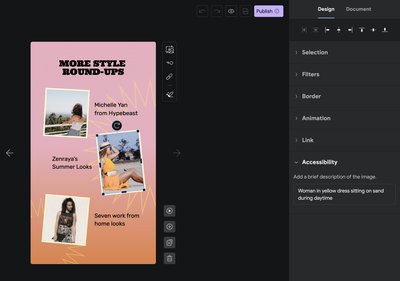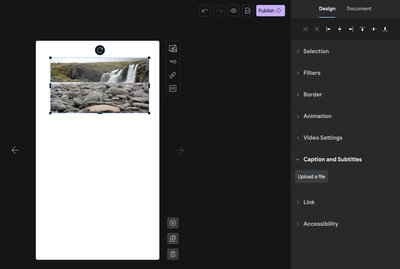Web Story publishing checklist

You’ve created a visually stunning immersive Web Story that you can’t wait to share with the world, congratulations! We’re just excited to see it as you are to hit publish. Before and after you do, follow this list of best practices to help ensure your story is successful.
Add accessibility features
Web Stories are best when shared, and should be enjoyable for everyone. Not everyone is able to see or hear your Web Story the way you intended. By taking a few extra moments, you can help these users by making your Web Story accessible.

Add text description to images and videos
Include a text description of visual media for those who are visually impaired. Make it descriptive of how it fits into the Web Story. Many Web Story editors have a text field available when you add images. In the WordPress story editor, you can find it by selecting the image and opening the "Accessibility" menu in the Design panel.

In the WordPress story editor, you can find the alt image description by selecting the image and opening the "Accessibility" menu in the Design panel.
Caption videos and audio voice overs
Caption your videos and audio voice over so that hearing impaired, or readers with volume disabled, can get the full story. Many Web Story editors allow you to upload a caption file with your video. In the WordPress story editor, you can upload a file by selecting the video, opening the “Captions and Subtitles” menu in the Design panel, then clicking “Upload a file”.

In the WordPress story editor, you can upload a caption file by selecting the video, opening the “Captions and Subtitles” menu in the Design panel, then clicking “Upload a file”.
Follow SEO best Practices
Search engines like Google will need to find and understand the content in your Web Story to share it with the right audience. Following SEO best practices helps your story get discovered and indexed, and then shown to interested readers.
You can read more about where and how readers discover Web Stories in our Web Story discovery and promotion guide.

Web Story specific metadata
To help optimize your story’s presence on the web, you’ll need to add the right metadata to your story. Metadata is information about your story that provides helpful context about its content. These are the essential metadata to include in each Web Story:
- Title: A descriptive and concise title, ideally under 40 characters.
- Publisher Name: This can be the name of your blog, brand or whichever name you use for your content on the web.
- Publisher Logo: Web Stories include a publisher logo when previewed on Google. Add a 96x96px logo that represents your brand. You should use the same logo for all of your stories.
- Poster Image: The image displayed to users on the web before they open your story. This image should be at least 640x853px and contain no text.
Your editor of choice will likely have a field for each of these in the publishing flow. The Web Stories for WordPress editor includes a checklist to ensure each of these is set before you hit publish.
General metadata
Remember that Web Stories are web pages, so you should treat your web story SEO as such. Including all the typical web page metadata will give your stories an extra SEO boost.
- Include a description for your story. This is the description of your overall story, rather than descriptions for individual images and videos. Stories with a description tend to do better on search and have a wider reach.
- Link to your Story on your Site or Social Pages. Linking stories from your home page or category pages on your blog or website will make it easier for search engines to find and index your Web Stories.
- Avoid Burned-in-Text in images and videos. Text burned into an image or video is not detectable by search engines and screen readers. You should always add text as a separate layer in your Web Story.
- Add schema.org structured data. Web stories use the Article schema.org structured data. This is a more advanced tip, but you can learn more in this article if you’d like to dive in deeper.
- Add OGP to your Story. OGP stands for Open Graph Protocol and is a way to control how your story appears on social sites like Facebook. OGP can help with SEO, but may need to be added manually as most editors do not include an option to add OGP.
Setup analytics
It’s important to understand how your Web Stories are performing once you publish them to the web. Be sure to set up analytics for your stories so you can begin tracking from the moment you share them. Read more about setting up and analyzing your Web Story performance in our Analytics guide.
Test your Web Story
Web Stories are technically just Web Pages built on the AMP framework. Therefore, they contain AMP code and should be checked for valid AMP. While it isn’t important for you to know how to build with AMP, checking for validity will give you insights to things that may need to be fixed.
Check your Web Story AMP validity by copying the published URL into the AMP Test Tool or AMP Validator to run the test. These tools will check your story’s code and highlight any errors. The most common errors are due to missing metadata, like Title or Poster Image.
If you’re using Web Stories for WordPress, other WordPress plugins may add additional code to your stories after publishing and cause AMP errors. The AMP report in Google Search Console is a helpful tool to monitor your stories for any AMP errors after you’ve published them. You can always edit your Web Story and republish with improved features!



